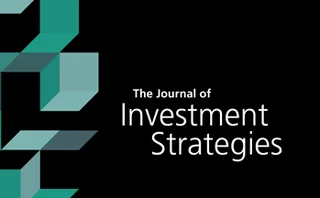Asset allocation
CalSTRS CIO: new derivatives needed to hedge ESG risks
Second-largest US pension fund has also reduced fixed income allocation to 12% as rates have fallen
EU insurers’ fund holdings battered by Covid in Q1
Total asset portfolios declined 6% through Covid shock
Covid recession makes US insurers’ junk bond piles riskier
About $227.5 billion of firms’ debt holdings are BB+ rated or lower
The changing shape of buy-side risk technology
Buy-side risk managers and FactSet’s global head of quantitative analytics gathered for a Risk.net webinar to discuss topical risk management trends for asset managers and to consider the industry challenges posed by the recent Covid‑19 pandemic
For a post-Covid world, quant fund revives a contentious idea
Crisis puts out-of-vogue practice of “porting” alpha back in play
A regime-switching factor model for mean–variance optimization
In this paper the authors formulate a novel Markov regime-switching factor model to describe the cyclical nature of asset returns in modern financial markets.
‘Quantamental’ approach convinces Morgan Creek CEO
Proponent of big-picture investing sees growing role for machines, but with caveats
Ripping up the old asset class labels
Outmoded classifications of securities may be concealing market risk. AI has a better idea
Allocation models that know their unknowns
Quants say probabilistic programming beats machine learning in balancing strategies
Quant funds look to AI to master correlations
Machine learning shows promise in grouping assets better, predicting regime shifts
Low investment grade debt a staple of EU insurer portfolios
Debt holdings just one notch above junk status make up €642.8 billion of standard formula insurer assets
BNY Mellon leads US custody banks’ assets increase
Total Auca stood at $94.4 trillion at end-September
Factor-based tactical bond allocation and interest rate risk management
This paper offers two composite bond market factor investment strategies each for the Swiss bond market and for the global sovereign bond market.
Asset correlation estimation for inhomogeneous exposure pools
This study investigates the systematic error that is made if the exposure pool underlying a default time series is assumed to be homogeneous when in reality it is not.
Beyond market equilibrium – The future of active investing
Asset owners use indexes as policy benchmarks and reference portfolios in their asset allocation. Index investors track cap-weighted indexes that seek to capture the market return. Active investors select securities and build portfolios that aim to…
Parameter estimation, bias correction and uncertainty quantification in the Vasicek credit portfolio model
This paper is devoted to the parameterization of correlations in the Vasicek credit portfolio model. First, the authors analytically approximate standard errors for value-at-risk and expected shortfall based on the standard errors of intra-cohort…
Poor asset returns threaten EU insurers’ profitability
Life insurers report median zero investment return in 2018
Eurozone insurers’ bets on alternatives raises systemic risk
Dutch firms have more than 25% of total assets tied up in non-traditional investments
Tying allocation to selection
Hamza Bahaji introduces a new approach to core-satellite investing, the compound portfolio insurance
Accounting switch saps Ping An's investment yield
IFRS 9 lops 37 billion yuan from investment return
Derivatives assets soar at eurozone insurers
Surge in values near year-end hint at hedging gains
EU hedge funds lean on repo for leverage
Around 60% of EU hedge fund borrowings due within one week, Esma reports
Active ETFs – The next step in Asia’s ETF innovation
The exchange-traded fund space has long been dominated by passively managed funds, but active ETFs are gaining popularity among investors and issuers. Although active ETFs are not yet a mainstream investment instrument, their growing investor interest is…
















